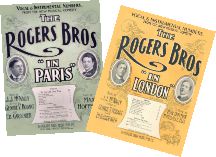|
Daisy was ambitious.
After recognition in church choir
and school theater, her eyes were
drawn to
the professional stage.▼1
In March 1903 she enrolled in
Klaw & Erlanger's stage
school at the Knickerbocker Theater.
Her instructors recognized her
talent in singing and dance and she
was offered an opportunity to go on
the road with a K&E company.
With her press release she snared a
photo and multi-paragraph story in
one major daily and a paragraph in a
few others.
At the
Iroquois
On the day of the Iroquois Theater
fire, Daisy and a friend, a fellow
chorus girl named Agnes Teresa
(unknown last name) of Jersey, and
two other chorus girls were
preparing to sing in the upcoming
Ma Honey number. Eddie
Foy's act with the elephant was to
follow the Pale Moonlight scene and
Ma Honey would follow Eddie
Foy.
Along with twenty-one other
chorus girls they were in the
basement dressing rooms. The niece
of the lady who helped dress the
chorus,
Stella Follis, was the first to
alert them that the theater was on
fire. They kept dressing until they
were told to get out but Daisy said
they were not afraid. They went out
onto the stage, then out into the
lobby. There wasn't yet a crowd in
the lobby so they returned to their
dressing room and gathered their
street clothes, then back to the
lobby and out the front doors of the
Iroquois, without difficulty. They
walked next door to Thompson's
restaurant and were given private
rooms. (Thompson's was a narrow
dinner without a private dining area
so I suspect that by "private rooms"
Daisy meant an area away from the
dining area where they could change
from their costumes to their street
clothes, such as a food preparation
area or pantry.) When the
girls returned to the dining area
there were only two injured people
in the restaurant. Out on the street
a large crowd was gathering and
they learned for the first time that
there were dead and injured.
They went to a paint store and
telegraphed to their families that
they were safe, then went on to the
Bush Hotel where most of the chorus
girls were staying and remained
there.
|
|
|
Daisy Ashton Chaffee
(1883–1954) had begun lending her soprano voice
to the choir at St. Andrews
Protestant Episcopal Church of Brooklyn▼2 as a
fifteen-year-old in 1898.
Over the next five years she also performed in
a few amateur theater productions.
Klaw & Erlanger's stage school in 1903
was operated at the Knickerbocker Theater where Mr.
Bluebeard was running with less-than-outstanding audiences
but Daisy did not join the Bluebeard cast
while it was on Broadway. Her first
professional engagement was to be in Max Hoffman's
The Rogers Brothers in London, scheduled
to open at a new K&E's theater, the
New Amsterdam▼3 on 42nd St.
Construction delays forced changes in plans.
Rogers Brothers did a week in Buffalo in August
then the next month opened on Broadway at the
Knickerbocker — which had become available
in May when Mr. Bluebeard played it's
last performance on Broadway. Based on
promotional blurbs provided by Daisy to
newspapers, she would have been in the
Bluebeard road company's first performance
on September 28 at the Alvin Theater in
Pittsburg and as it moved on to
Cleveland, Indianapolis, St. Louis, and
Chicago where it opened on November 23, 1903.
In a cast with hundreds of dancers and singers,
her performance was not remarked upon in the
press.
Daisy was the daughter of Elsie Walsh (1866–1918) and James
Ashton. Her parents' marriage didn't last
but Elsie's second marriage, to Dr.
George Chaffee (1855–1922), lasted until her death. It is not known if Chaffee
legally adopted his step daughter but until
marriage, after George's death, she used
his last name as a young woman, designating
"Daisy Ashton" as her stage name.
Dr. George Chaffee was a prominent allopathic
physician who specialized in medical care to
railroad passengers and bone surgery. He
founded the small Bay Ridge Sanitarium that
operated in Manhattan from 1912 to 1926.
|

|
In the years after the fire
Daisy performed in the chorus of Rogers
Brothers in Paris in 1904 and Rogers
Brothers in Ireland in 1906, Chocolate
Soldier in 1910 while with the Whitney Opera
Company. She had aspirations of an
operatic career but that didn't come to pass.

By 1919 Daisy had given up the stage and
worked as a manicurist and hair dresser on Court Street in
Binghamton, NY.
In 1922 she
married a 5'4" shoe-worker-turned-farmer seven
years her junior, Seymour Charles Baldwin(1890–1977).
It was such an improbable match that I
double-checked the marriage license. The
Baldwins lived in Broom, NY in the 30s then in
the 1940s relocated to Rome, PA where Seymour
operated a dairy on Allis Hollow Rd (Route 467).
In 1947 he sold the dairy, including 40 Holstein
and Guernsey cows. Daisy's mother and
stepfather, George Chaffee, were buried in
nearby Warren Center,
Daisy's brief obituary made no mention of
her stage career. I found nothing to
indicate that she had children. She
suffered a stroke in 1952 and was left invalid
enough to require a caretaker and part-time
housekeeper for their small apartment.
Daisy died of uterine cancer.
|
|
Discrepancies and addendum
1.
Jessie Bartlett Davis, wife of
Iroquois Theater manager Will J. Davis, was one
such example.
2. In 1898 the forty-member
male-only vested
choir at St. Andrews had been directed by organist Mallinson Randall. By
1901, however, the church also had a male / female
choir and fifteen-year-old Daisy Chaffee was one of the members.
3. The Klaw &
Erlanger theater syndicate relocated its offices to the
floors above the New Amsterdam Theater.
|
